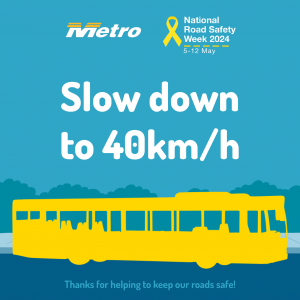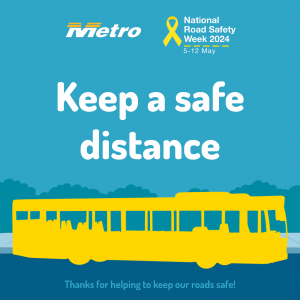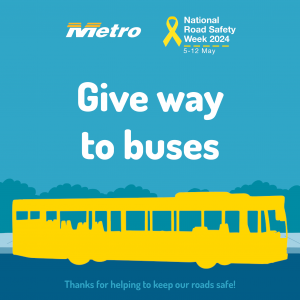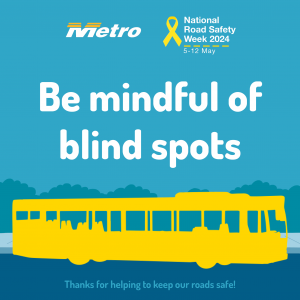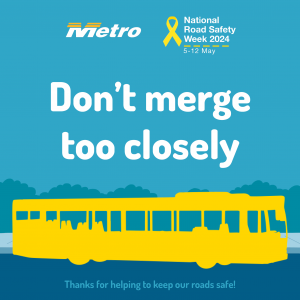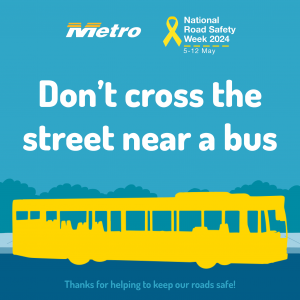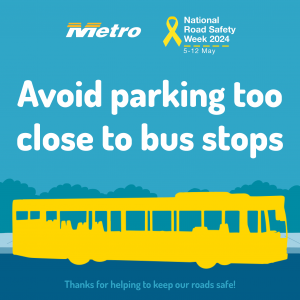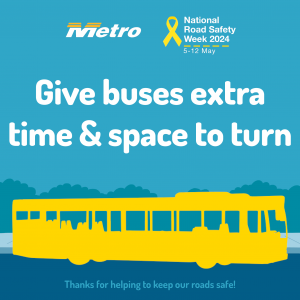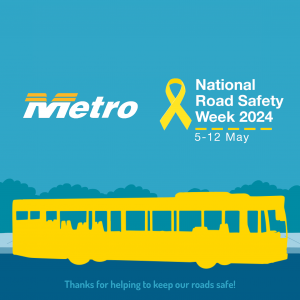Today marks the start of National Road Safety Week – an important reminder of how we can all work together to keep our roads safe.
At Metro, we work hard to keep Tasmania moving and, as a major user of Tasmanian roads, we’ve put together eight Bus Safety Tips to help keep you and our customers safe when sharing the roads with buses. We’re committed to doing our bit to help improve the safety of our roads for everyone.
Find out more about National Road Safety Week and take the Pledge to drive so others survive.
1. Slow down to 40km/hr
Slow your car down to 40km/h if you’re within 50 metres of a bus displaying warning lights.
Whether you’re driving behind a bus or approaching it from the opposite direction, it’s important to reduce your speed to make sure buses have the space to safely stop or merge into traffic, and that our passengers have time to safely get off. Buses are heavy vehicles and often need a little more time and space from other drivers to keep us all safe.
2. Keep A Safe Distance
Safe driving means maintaining a safe distance between your vehicle and any buses ahead to allow for any sudden changes. Try to keep at least four seconds between your vehicle and a bus.
Buses are heavy vehicles, so they often need more time and space to stop. Keeping enough distance when you’re driving behind a bus is an easy way to help keep everyone safe on the roads we share.
3. Give way to buses
Our roads are safer when we look out for each other. When you’re driving, you can help keep everyone safe by giving way to buses ahead of you:
- When they’re stopped or moving slowly on the shoulder of the road or at a bus stop.
- If they display a ‘Give Way to Buses’ sign.
- When they signal right.
- When they’re about to enter your lane.
4. Be mindful of blind spots
Like any other vehicle, buses have blind spots. These are located at the front, rear, and sides of the bus. Our drivers go through extensive blind spot monitoring training, but it is important that everyone on the road stays aware and safe – whether you’re a pedestrian or driving another vehicle, please exercise caution around buses.
5. Don’t merge too closely
Our drivers work hard to maintain a safe distance by leaving a 4-second gap between buses and surrounding vehicles. This gap allows us sufficient time to react and respond to potential traffic incidents. Please be mindful of the bus’s accident-avoidance space when merging from a side road or changing lanes.
Buses are heavy vehicles and need more time and space to stop.
6. Don’t cross the street near a bus
It’s important to exercise caution to stay safe when exiting or walking nearby a bus. Crossing the road in front of a bus can be dangerous as buses are heavy and need extra time to stop safely.
Just like cars, buses have blind spots which means a driver may not be able to see you when moving around the front or side of the bus.
Thanks for being extra vigilant when moving around buses by waiting until the bus has left the stop before crossing the street and always cross at designated crossing point.
7. Avoid parking too close to bus stops
When parking your car, always double check to see if there’s a bus stop nearby. If cars are parked too close to bus stops, our bus drivers can’t pull up as effectively, which may lead to traffic disruptions or difficulty for passengers getting on and off buses.
Of course, it can sometimes be hard to judge how much space is enough space. Did you know that the Tasmanian Government restricts parking to 20 metres before and 10 metres after a designated bus stop? Buses need this extra space to manoeuvre in and out of bus stops without disrupting traffic or risking the safety of motorists and passengers.
8. Give buses extra time and space to turn
Did you know that buses need to pull up to a bus stop at an angle so that bus drivers have the necessary extra space to turn safely? Buses turn primarily with the rear axle and therefore need an angle to safely pull up and out of bus stops without hitting signage or cars that may have parked too close to the stop.
So, if you find yourself behind a bus pulling into a stop at an angle, please be patient. The bus will move on shortly. Overtaking or pulling up too close will make it harder for the bus to turn, which may lead to longer delays.
Buses are big, heavy vehicles, so they will need extra time and space to drive safely. We thank you for your patience, which helps us prioritise safety on the roads we share.
Thank you for taking the time to read over our road safety tips. Let’s all stay alert, stay patient, and think of safety first when on the roads we share, whether as a pedestrian, driver or passenger.
For more information about National Road Safety Week, or to take the Pledge to drive so others survive, visit the official website.

